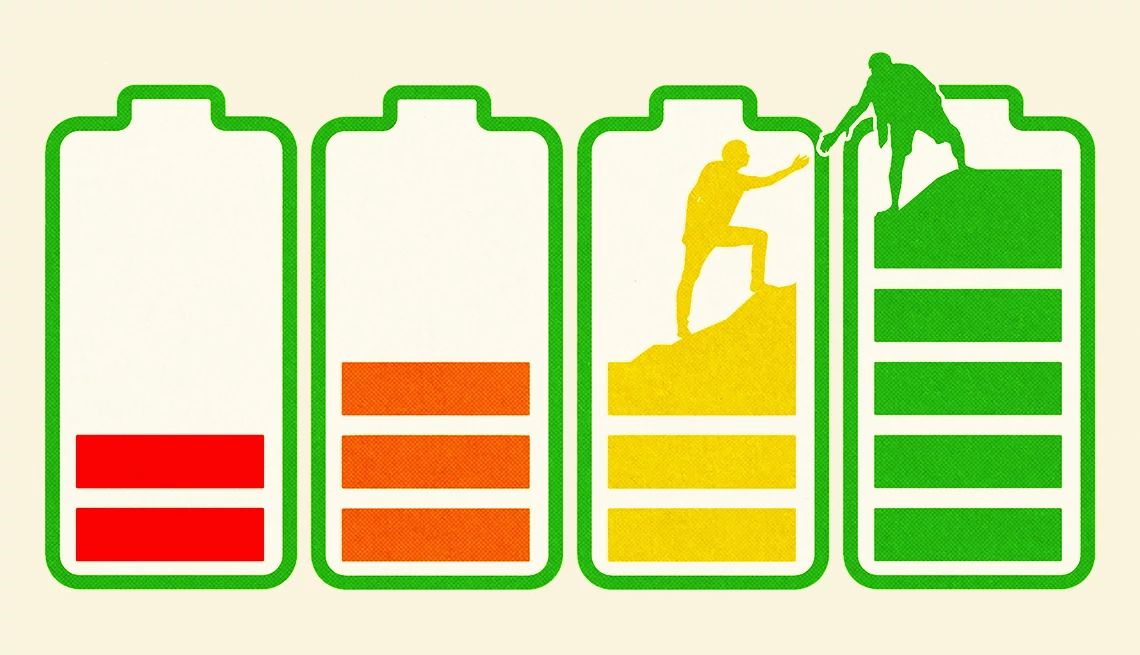AARP Hearing Center


Perky Passionate. Powerful. How much do those words describe you? In a 2025 meta-analysis, 3 out of 5 adults over 60 described themselves as being easily fatigued after doing normal activities. This slowdown isn’t healthy. Age-related fatigue is associated with increased mortality risk, due to the likelihood of physical decline and the development of conditions that impair your ability to do daily tasks.
It doesn’t have to be this way. Researchers who study energy metabolism say there are four (very doable) things that can help turn back the clock on your cells to restore your energy level — and maintain it well into your later years.
Why our batteries run low
Mitochondria are structures that act as the energy processors of our cells. Using the food we eat, they create a molecule called adenosine triphosphate (ATP), the chemical energy currency all our cells run on. “Mitochondria are not the only providers of energy, but they do the heavy lifting, especially when it comes to the activities of daily living,” explains Ian Lanza, professor of medicine at the Mayo Clinic College of Medicine and Science in Rochester, Minnesota.
As we age, our cells become less efficient, putting increased demand on the mitochondria. “Cells burn more energy than they should to do the same amount of work. This is like a car engine that’s rusting — it needs to expend more energy to go the same distance,” says Martin Picard, a mitochondrial psychobiologist at Columbia University.
As your brain senses that your cells are in overdrive, it looks to conserve energy elsewhere: It slows down the process of rebuilding muscle, causing you to lose muscle mass. It reduces melanin production, leading to gray hair. And you naturally become less physically active, which atrophies muscles and encourages the body to make fewer mitochondria to save even more energy. This loss of natural energy, called the “brain-body conservation model of aging,” winds up backfiring by creating physical fatigue that diminishes the long-term health and vitality of your body. “This begins a spiraling down into frailty,” Picard says.
But this spiral isn’t inevitable.Lifestyle changes can increase the number of mitochondria and help keep your cells — and you — feeling more energetic.
1. Don’t stop moving
Like muscles, mitochondria work on a “use it or lose it” basis, says Lanza. “There are big differences in energy metabolism between people who have a sedentary lifestyle versus those who maintain physical activity,” he says. “When older adults are able to maintain healthy guideline-recommended levels of physical activity, there are fewer age-related deficits in mitochondrial function.”
Your move: Aim for the recommended 150 minutes of moderate-intensity activity, plus two days of muscle-strengthening activity, per week. How do you know if you’re working hard enough? “If you do something and find you’re breathing harder—going upstairs, walking somewhere, having sex — you’re stimulating your mitochondria,” says Picard.




































































More From AARP
The Dangers of Hidden Caffeine for Older Adults
Highly caffeinated drinks can cause unwanted and even dangerous side effects
How to Get More Explosive Muscle Power After 50
These 5 expert tips will help you stay strong and mobile while avoiding injury
25 Tips for Boosting Energy for People 50-Plus
You have the power to energize your days. Here’s a long list of ideas